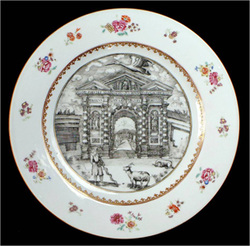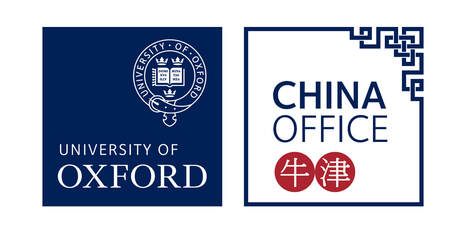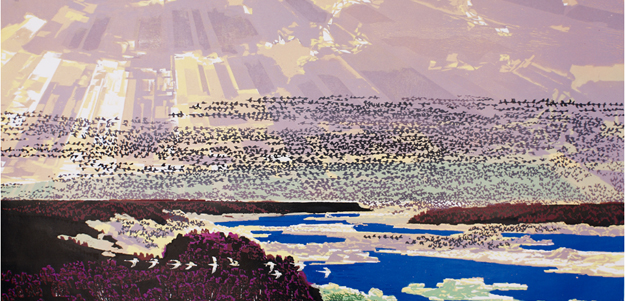Spotlight on Oxford
Oxford In China > Spotlight > China and the Ashmolean
SPOTLIGHT ON
CHINA AND THE ASHMOLEAN
On the occasion of its first ever major exhibition of a contemporary artist, Xu Bing, we take a closer look at the Ashmolean’s impressive Chinese collections.
CHINA AND THE ASHMOLEAN
On the occasion of its first ever major exhibition of a contemporary artist, Xu Bing, we take a closer look at the Ashmolean’s impressive Chinese collections.
The Ashmolean is well known for having the world’s greatest collection of Raphael drawings and alumni may well remember its superb Egyptian and Anglo-Saxon artefacts, but did you know that it also has one of the world’s foremost collections of modern Chinese paintings in the western world? Its collection of Chinese ceramics, bronzes and jades is also one of the most significant of its kind and it has one of the largest groups of Ming and Qing dynasty porcelain in the world. So how did the world’s first public museum, founded in 1683, come to amass such as impressive Chinese collection?
The galleries dedicated to the art of China
The Ashmolean’s collection of Chinese art and archaeology is permanently displayed in three galleries, the Gallery of Early China (to AD 800), the Chinese Paintings Gallery, and the Gallery of Later China (from AD800).
Since it was founded, the Ashmolean has evolved to become a world-renowned ‘collection of collections’, reflecting the passion, dedication and scholarly interest of the collectors who brought them together. For example, most of the classic ceramic wares of the Tang and Song dynasties (7th–13th centuries) were given to the Museum in the 1950s by the great collector Sir Herbert Ingram, who was particularly interested in celadon greenwares – ‘the backbone of Chinese ceramics’. His determination to acquire the finest examples on the market in the 1930s and 1940s has resulted in the Ashmolean having a collection of greenwares unrivalled outside China, besides its other strong holdings of blue-glazed Jun wares and all kinds of white and black wares. The extensive holdings of later porcelain comprise Gerald Reitlinger’s collections, as well as several historic collections donated to the Museum in the late 19th and early 20th centuries including those of Gaspard Farrer, Francis Mallett and Professor A. H. Sayce.
As wood sculptures do not survive in great quantity, the Ashmolean is fortunate to have two rare bodhisattvas of the 10th–13th centuries, which were both recovered in Shanxi province in north China in the 1920s. These important sculptures are a central feature of the Ashmolean’s public displays, and are used in its schools educational programme to highlight the spread of Buddhism throughout China and for teaching about religion more generally.
Scholarly life in traditional China is well represented by objects in a wide range of media, including brushpots, inkstones and brushes in different materials as well as a substantial collection of seals used by officials and artists. But scholarly life is more strongly shown in the Museum’s paintings and calligraphy. At the core of its collection of paintings is a group of works by mid-20th century masters including Qi Baishi, Li Keran, Fu Baoshi and others, acquired in the 1960s when few collectors were focusing on this field. Since then the Museum has continued to build the collection, through gift and purchase, adding recent and contemporary works to reflect ongoing developments in Chinese art as well as paintings dating to the 19th century. The paintings also form part of the Eastern Art Online (http://jameelcentre.ashmolean.org/), often with extended curatorial material and background to the exhibition, which makes them available to the widest audience.
Crossing Cultures, Crossing Time
Following a £61 million redevelopment the Ashmolean is now home to new galleries and facilities and welcomes over 1.2 million visitors each year. At the heart of this ambitious transformation is an innovative new display strategy, Crossing Cultures, Crossing Time, which highlights interaction and influence between civilizations. Through this approach, objects and works of art from its Chinese collections are featured not only in the galleries dedicated to China but throughout the Museum, clearly demonstrating China’s impact and influence on other cultures from the Ancient world to modern times, a story literally showcased in the West Meets East Gallery.
The galleries dedicated to the art of China
The Ashmolean’s collection of Chinese art and archaeology is permanently displayed in three galleries, the Gallery of Early China (to AD 800), the Chinese Paintings Gallery, and the Gallery of Later China (from AD800).
Since it was founded, the Ashmolean has evolved to become a world-renowned ‘collection of collections’, reflecting the passion, dedication and scholarly interest of the collectors who brought them together. For example, most of the classic ceramic wares of the Tang and Song dynasties (7th–13th centuries) were given to the Museum in the 1950s by the great collector Sir Herbert Ingram, who was particularly interested in celadon greenwares – ‘the backbone of Chinese ceramics’. His determination to acquire the finest examples on the market in the 1930s and 1940s has resulted in the Ashmolean having a collection of greenwares unrivalled outside China, besides its other strong holdings of blue-glazed Jun wares and all kinds of white and black wares. The extensive holdings of later porcelain comprise Gerald Reitlinger’s collections, as well as several historic collections donated to the Museum in the late 19th and early 20th centuries including those of Gaspard Farrer, Francis Mallett and Professor A. H. Sayce.
As wood sculptures do not survive in great quantity, the Ashmolean is fortunate to have two rare bodhisattvas of the 10th–13th centuries, which were both recovered in Shanxi province in north China in the 1920s. These important sculptures are a central feature of the Ashmolean’s public displays, and are used in its schools educational programme to highlight the spread of Buddhism throughout China and for teaching about religion more generally.
Scholarly life in traditional China is well represented by objects in a wide range of media, including brushpots, inkstones and brushes in different materials as well as a substantial collection of seals used by officials and artists. But scholarly life is more strongly shown in the Museum’s paintings and calligraphy. At the core of its collection of paintings is a group of works by mid-20th century masters including Qi Baishi, Li Keran, Fu Baoshi and others, acquired in the 1960s when few collectors were focusing on this field. Since then the Museum has continued to build the collection, through gift and purchase, adding recent and contemporary works to reflect ongoing developments in Chinese art as well as paintings dating to the 19th century. The paintings also form part of the Eastern Art Online (http://jameelcentre.ashmolean.org/), often with extended curatorial material and background to the exhibition, which makes them available to the widest audience.
Crossing Cultures, Crossing Time
Following a £61 million redevelopment the Ashmolean is now home to new galleries and facilities and welcomes over 1.2 million visitors each year. At the heart of this ambitious transformation is an innovative new display strategy, Crossing Cultures, Crossing Time, which highlights interaction and influence between civilizations. Through this approach, objects and works of art from its Chinese collections are featured not only in the galleries dedicated to China but throughout the Museum, clearly demonstrating China’s impact and influence on other cultures from the Ancient world to modern times, a story literally showcased in the West Meets East Gallery.

The new display strategy is best described with an example - a Chinese porcelain plate made for export in the 18th century, called the ‘Oxford plate.’ The image on the face of the plate is of the Danby Arch in the Botanical Gardens in Oxford and is taken from an engraving published in 1713. It is thought that Humphrey Sibthorpe, Sherardian Professor and Keeper of the Garden, commissioned this plate in 1753. A copy of the engraving was sent to China from England, which was then meticulously painted, fired and sent back to England, and now form a remarkable example of trade and exchange between West and East over 250 years ago.
Temporary Exhibitions of Chinese Art
Besides its permanent displays, the Ashmolean also regularly feature temporary exhibitions of Chinese art throughout the museum. Currently there is an exhibition of contemporary Chinese art from the collection of the renowned art historian Professor Michael Sullivan, who is also one of the major Western pioneers in the field of modern Chinese art history.
Temporary Exhibitions of Chinese Art
Besides its permanent displays, the Ashmolean also regularly feature temporary exhibitions of Chinese art throughout the museum. Currently there is an exhibition of contemporary Chinese art from the collection of the renowned art historian Professor Michael Sullivan, who is also one of the major Western pioneers in the field of modern Chinese art history.
An exhibition in the new year, opening on February 28th, will be 'Landscape Landscript' by Xu Bing, and will be the first major exhibition of a contemporary artist in the museum. The works of Xu Bing, considered one of the most important contemporary Chinese artists of his generation, will be shown across four galleries and is based on the artist's famous 'Landscript' works. This series uses Chinese characters for natural features to compose a landscape painting. this will be the first comprehensive exhibition of Xu Bing's work to be shown anywhere in the world and represents an exciting new direction for the Ashmolean.
The key staff member overseeing this exhibition is Shelagh Vainker, curator of Chinese Art at the Ashmolean and fellow of St Hugh’s college. Her position is a unique one. The curator of Chinese Art is a key member of the University of Oxford academic staff, holding the only established teaching post dedicated to Chinese Art at the university. At the same time, the curator is responsible for the care of the Museum’s Chinese collections, maintaining the permanent gallery displays and mounting temporary exhibitions. The Curator also undertakes and publishes research on the collections and is central in promoting knowledge and understanding about Chinese art and culture to students and members of the public alike.
Ms Vainker’s research interests include the arts of the Northern Song dynasty and modern Chinese painting, and she directs a graduate course in Modern Chinese Art, as well as more general undergraduate teaching in Chinese art, within the Faculty of Oriental Studies. Her recent publications include Chinese Paintings in the Ashmolean Museum, Oxford (Oxford, 2000), " Chinese Silk: A Cultural History, (London,British Museum Press, 2004), Pu Quan and his Generation: Imperial Painters of Twentieth century China (Oxford, 2004). As the recipient of the J.S. Lee Memorial Senior Fellowship, established by distinguished Hong Kong philanthropist Dr Lee Jung Sen, Ms Vainker has just spent six months at the Beijing Capital Museum to conduct research on the museum’s ceramic collection and to engage in exchange with Chinese museums.
The key staff member overseeing this exhibition is Shelagh Vainker, curator of Chinese Art at the Ashmolean and fellow of St Hugh’s college. Her position is a unique one. The curator of Chinese Art is a key member of the University of Oxford academic staff, holding the only established teaching post dedicated to Chinese Art at the university. At the same time, the curator is responsible for the care of the Museum’s Chinese collections, maintaining the permanent gallery displays and mounting temporary exhibitions. The Curator also undertakes and publishes research on the collections and is central in promoting knowledge and understanding about Chinese art and culture to students and members of the public alike.
Ms Vainker’s research interests include the arts of the Northern Song dynasty and modern Chinese painting, and she directs a graduate course in Modern Chinese Art, as well as more general undergraduate teaching in Chinese art, within the Faculty of Oriental Studies. Her recent publications include Chinese Paintings in the Ashmolean Museum, Oxford (Oxford, 2000), " Chinese Silk: A Cultural History, (London,British Museum Press, 2004), Pu Quan and his Generation: Imperial Painters of Twentieth century China (Oxford, 2004). As the recipient of the J.S. Lee Memorial Senior Fellowship, established by distinguished Hong Kong philanthropist Dr Lee Jung Sen, Ms Vainker has just spent six months at the Beijing Capital Museum to conduct research on the museum’s ceramic collection and to engage in exchange with Chinese museums.


